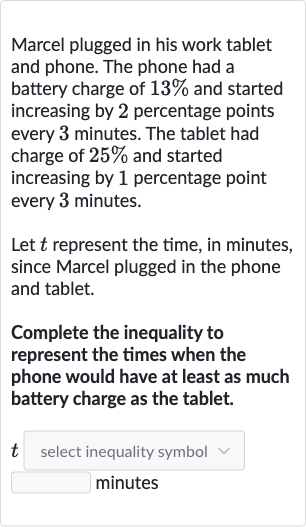AI tutor
Welcome to Bytelearn!
Let’s check out your problem:

Marcel plugged in his work tablet and phone. The phone had a battery charge of and started increasing by percentage points every minutes. The tablet had charge of and started increasing by percentage point every minutes.Let represent the time, in minutes, since Marcel plugged in the phone and tablet.Complete the inequality to represent the times when the phone would have at least as much battery charge as the tablet. select inequality symbol minutes
Full solution
Q. Marcel plugged in his work tablet and phone. The phone had a battery charge of and started increasing by percentage points every minutes. The tablet had charge of and started increasing by percentage point every minutes.Let represent the time, in minutes, since Marcel plugged in the phone and tablet.Complete the inequality to represent the times when the phone would have at least as much battery charge as the tablet. select inequality symbol minutes
- Define phone charge function: Let's define the battery charge of the phone as a function of time, . The phone starts with a charge and increases by percentage points every minutes. So, the charge of the phone after minutes can be represented as:Phone charge =
- Define tablet charge function: Similarly, we can define the battery charge of the tablet as a function of time, . The tablet starts with a charge and increases by percentage point every minutes. So, the charge of the tablet after minutes can be represented as:Tablet charge =
- Set up inequality: We need to find when the phone's charge is at least as much as the tablet's charge. This means we are looking for the time when the phone's charge is greater than or equal to the tablet's charge. So, we set up the inequality:
- Eliminate fractions: To solve the inequality, we will first eliminate the fractions by multiplying every term by to get rid of the denominators: This simplifies to:
- Isolate variable: Next, we will isolate on one side of the inequality by subtracting from both sides:This simplifies to:
- Solve for t: Now, we subtract from both sides to solve for : This simplifies to:
- Final result: The inequality represents the times when the phone would have at least as much battery charge as the tablet.
More problems from Solve linear equations with variables on both sides: word problems
QuestionGet tutor help
QuestionGet tutor help
QuestionGet tutor help
QuestionGet tutor help
QuestionGet tutor help
QuestionGet tutor help
QuestionGet tutor help
